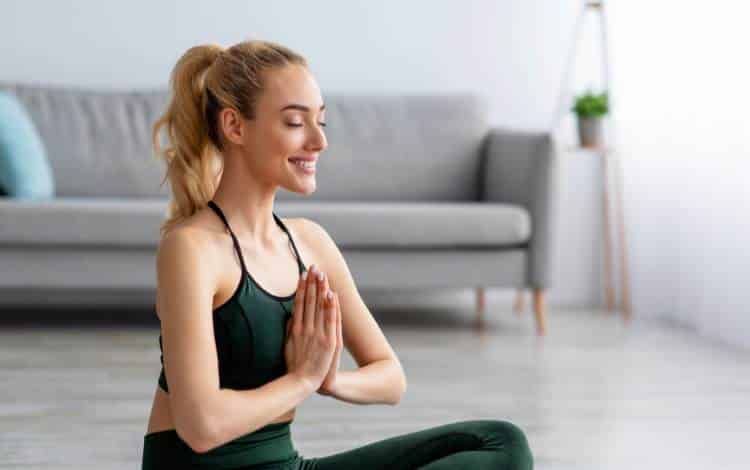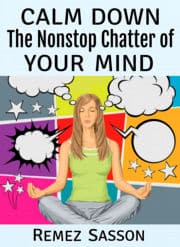
Embarking on the journey of meditation brings you to the threshold of experiencing the present moment without judgment, offering a sanctuary for your mind to rest and rejuvenate.
As a beginner in meditation, you don’t need to worry about silencing your thoughts. This is more for advanced practitioners.
As you delve into how to meditate as a beginner, you’ll uncover the beauty of various meditation practices, including mindfulness, guided meditation, and yoga, each paving the way to enhanced personal well-being.
Browse our online courses on meditation, positive thinking, overcoming procrastination, confidence, and freedom from distractions.
This article teaches how to start a meditation practice at home and seeks to help you embed this enriching routine into your daily life. This will bring you dividends like better sleep, less pain, lower blood pressure, and a substantial decrease in anxiety and depression.
Whether you’re curious about how long to meditate or how to incorporate meditation into your everyday routine seamlessly, you’re positioned to uncover the essence of true inner peace and balance.
Understanding the Basics of Meditation
Understanding the basics of meditation is essential for beginners, and it involves more than just sitting quietly.
Here’s a breakdown to help you grasp the foundational elements:
Core Components of Meditation
- Focused Attention: Essential for guiding your mind away from distractions.
- Relaxed Breathing: This technique involves deep, even-paced breaths to reduce stress.
- A Quiet Setting: Preferably a serene environment to minimize interruptions.
- A Comfortable Position: Sit or lie in a position that you find relaxing.
- Open Attitude: Let thoughts pass without judgment and return your focus gently.
Types of Meditation:
- Guided Meditation: Uses visualization or imagery to relax.
- Mantra Meditation: Focuses on a silently repeated word or phrase.
- Mindfulness Meditation: Centers on being intensely aware of what you’re sensing and feeling in the moment, without interpretation or judgment.
- Movement-Based Meditation: This includes practices such as Yoga, tai chi, and Qigong, which focus on gentle movements.
Everyday Meditation Practices
- Deep Breathing: Simple yet powerful; can be done anywhere to relax.
- Body Scan: Mentally scanning your body for areas of tension and consciously relaxing them.
- Walking Meditation: Combining gentle walking with mindfulness.
- Loving-Kindness Meditation: Focusing your mind on developing feelings of goodwill towards yourself and others.
By incorporating these practices, meditation can serve as a tool for stress relief, fostering a deeper connection with oneself, and enhancing overall well-being.
Preparing for Your First Meditation Session
Preparing for your first meditation session is vital to a successful practice. Here are some guidelines to get you started:
Setting Up Your Meditation Space
- Choose a Quiet and Comfortable Place: Ensure the area is tidy, clean, and free from distractions. If available, this could be a corner of your bedroom or a dedicated room.
- Prepare Your Space: Remove any clutter and dim the lights. Creating a calming environment aids in focusing and relaxation.
- Comfortable Seating: Find a comfortable position that allows you to sit with a straight back, relaxed neck and shoulders, and a slightly tucked chin. If necessary, using supports can help you maintain this posture without strain.
Getting Ready for Meditation
- Timing and Duration: Start with short meditations of 5-10 minutes and gradually increase the duration. Commit to meditating at the same time each day, preferably in the morning, to harness the calmness of the day’s start.
- Prepare Your Body: Engage in light yoga stretches or movements to release physical tension. Ensure you’re not feeling hungry, thirsty, or overly full before starting.
- Mindfulness and Focus: Begin your session with a few deep breaths to settle your mind. Focus on your breath, allowing thoughts to pass without judgment and returning your attention to breathing whenever it wanders.
Guidance and Support
- Utilize Guided Meditations: Guided meditations can provide motivation and practical advice from experts for beginners. This can be especially helpful for navigating the initial challenges of maintaining focus.
- Seek Support: Don’t hesitate to ask for help or explore resources online or in-person for meditation classes or instructors. Connecting with a community can offer additional motivation and insights.
By adhering to these preparatory steps, you’re well on your way to integrating meditation into your daily routine, setting the foundation for a practice that enhances mindfulness and well-being.
Common Meditation Techniques for Beginners
Exploring the plethora of meditation techniques available can be an enlightening part of your journey into meditation. Here are some common methods tailored for beginners:
- Basic Meditation: Start by focusing on your breath. Notice when your mind wanders and gently guide it back to your breath without judgment.
- Focused Meditation: Choose a point of focus, such as a visual, a sound, or even a simple concept. Aim to keep your attention on this focus without thinking about it further.
- Mindfulness Meditation: This technique encourages you to stay present, observing your thoughts and feelings without judgment. It can be practiced anywhere, anytime, making it highly accessible.
Each of these techniques offers a unique pathway to achieving mindfulness and relaxation. Experiment with them to find what best suits your needs and preferences.
Dealing with Challenges
In the journey of beginners in meditation, encountering challenges is a natural part of the process. Here’s how to navigate some common obstacles:
Mind Wandering and Boredom
- Accept that your mind will wander; it’s part of the learning curve.
- Gently guide your focus back to your meditation whenever you notice your attention has drifted.
- Practice observing your thoughts without engaging with them, fostering a kind and non-judgmental attitude towards yourself.
Physical Discomfort and Restlessness
- Begin with shorter sessions and gradually increase the duration as you become more comfortable.
- Experiment with different postures or try walking meditation if sitting still is challenging.
- If you experience uncomfortable sensations, adjust your posture, ensure you’re dressed appropriately for the climate, and don’t hesitate to take brief breaks if needed.
Emotional and Mental Barriers
- Confront emotional distress by acknowledging and embracing your feelings.
- Addressing the Five Hindrances (desire, anger, restlessness, sleepiness, doubt) involves recognizing their presence, naming them, and gently refocusing on your meditation practice.
Remember, the key to overcoming these challenges lies in patience, persistence, and adapting the practice to suit your unique needs and circumstances.
Incorporating Meditation into Your Daily Life
Incorporating meditation into your daily life doesn’t have to be a monumental task. Here are practical ways to seamlessly integrate this practice:
Daily Activities as Meditation Opportunities
- Turn routine tasks into moments of mindfulness. Whether you’re doing house chores, taking a shower, or at the office, focus your senses on the activity at hand and embrace the present moment.
- Morning routines can set a positive tone for the day. Wake up to gentle sounds, avoid immediate electronic use, and consider starting with at least three minutes of meditation to clear the mind and reduce stress.
Creating a Meditation Habit
Consistency is crucial. Aim to meditate every day, setting realistic durations for each session. Regular check-ins with yourself can help maintain this routine.
Mindful Activities for Enhanced Well-being
- Engage in activities that encourage mindfulness, such as yoga, listening to the sounds in your environment, walking, reading inspiring literature, etc. These can complement your meditation practice and further promote relaxation and focus.
- Consider joining a meditation group or attending a retreat. Meditating with others can provide support and motivation, enhancing your practice.
Conclusion
Throughout this guide, we’ve explored meditation’s vast landscapes, highlighting its simplicity and accessibility for beginners.
From understanding its core elements and various techniques to addressing common challenges and integrating them into daily life, we’ve laid a foundation for a practice that promises enhanced well-being and mindfulness.
Embracing each moment and being patient with oneself is vital to unlocking the myriad benefits of meditation.
Learn About Our Online Meditation Course
Various meditation techniques for finding inner peace, expanding consciousness, and awakening.
As you continue on this path, remember that meditation is about finding what works best for you and making it a part of your routine.
For further insight and strategies to quiet the mind, consider exploring our book Calm Down the Nonstop Chatter of Your Mind. It is designed to support your journey towards inner peace and mindfulness.
With practice and persistence, meditation can become a valuable tool for navigating life’s complexities, offering a sanctuary of peace and clarity amidst the noise of everyday existence.
Browse our online courses on meditation, positive thinking, overcoming procrastination, motivation, confidence, and freedom from distractions.


